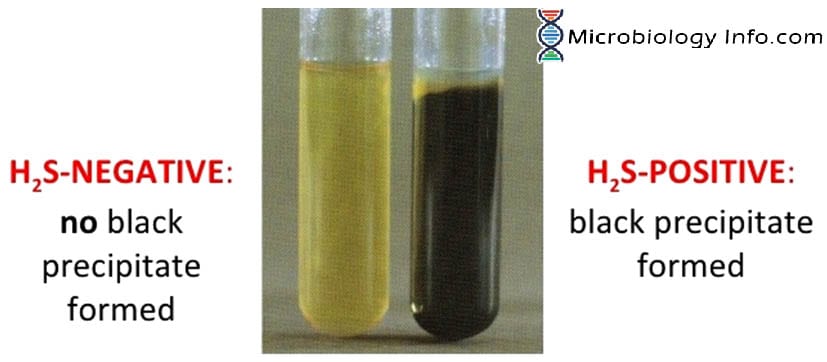Some microorganisms have an ability to reduce sulfur (Sulphur) containing compounds to hydrogen sulfide during metabolism which is commonly employed as a test measure for their identification in laboratories.
Numerous methods are used to detect H2S production by micro-organisms which vary with the source of sulfur and the metal salts used to indicate H2S formation. SIM is more sensitive in the detection of H2S than either TSI or KIA, because of its semisolid nature, its lack of interfering carbohydrates, and the use of peptonized iron as an indicator. However, Lead acetate paper is 10 times more sensitive than other media.
Objectives
To determine whether the microbe reduces sulfur-containing compounds to sulfides to produce hydrogen sulfide gas.
Principle
An iron compound and a sulfur compound are included in the test medium to test for the production of hydrogen sulfide gas.
Hydrogen sulfide is produced if the sulfur compound is reduced by the bacterial strain. This test thus determines whether the microbe reduces sulfur-containing compounds to sulfides during the process of metabolism.
H2S is produced by certain bacteria through reduction of sulphur containing amino acids like cystine, methionine or through the reduction of inorganic sulphur compounds such as thiosulfates, sulfates or sulfites during protein degradation or when anaerobic respiration shuttles the electrons to sulfur instead of to oxygen.
In either case H2S is produced (hydrogen sulfide gas) which reacts with the iron compound to form the black precipitate of ferric sulfide.
The black color acts as an indicator for the presence of hydrogen sulfide. The detection of hydrogen sulphide (H2S) gas produced by an organism. is used mainly to assist in the identification of that particular organism.
Media:
This test can be performed with the use of several media including Triple Sugar Iron (TSI), Kligler’s Iron Agar (KIA), SIM medium and Lead Acetate Paper.
- Sulphite indole motility (SIM) medium to detect H2S
This medium contains ferrous ammonium sulfate and sodium thiosulfate, which then together serve as indicators for the production of hydrogen sulfide. Production of hydrogen sulfide can be detected when ferrous sulfide, a black precipitate, is produced as a result of ferrous ammonium sulfate reacting with H2S gas.
Composition:
Beef extract 3.0 g Peptone 30.0 g Ferrous ammonium sulphat 0.2 g Sodium thiosulphate 0.025 g Agar 3.0g Final pH ( at 25°C) 7.3±0.2 Distilled water 1000ml
- Iron agars to detect H2S
This medium is suitable for detecting H2S production by enterobacteria. H2S is detected by the ferric citrate contained in the medium - Lead acetate paper test to detect H2S
When a sensitive technique for detecting H2S production is required, the lead acetate paper test is recommended.
Procedure
I. In Sulphite indole motility (SIM) medium
- Inoculate the organism into labeled tube by means of stab inoculation.
- Incubate the inoculated tubes at 37°C for 24-48 hours.
- Observe for the formation of black precipitate on the medium.
II. In Kligler iron agar (KIA) and Triple Sugar Iron Agar (TSIA)
- Inoculate the test organism into KIA and incubate it at appropriate temperature over night.
- Observe for blackening of the medium.
III. Lead acetate paper test
- Inoculate a tube or bottle of sterile peptone water or nutrient broth with the test organism.
- Insert a lead acetate paper strip in the neck of the bottle or tube above the medium, and stopper well.
- Incubate the inoculated medium at 35-37oC, and examine daily for a blackening of the lower part of the strip.
Results
- Positive result:Blackening on the medium
- Negative result:No blackening on the medium

Uses
- It is used mainly to assist in the identification of members of family Enterobacteriaceae and occasionally to differentiate other bacteria such as Bacteroidessps and Brucella sps.
- The test aids in the identification and differentiation of members of Enterobacteriaceae (enterics) from other Gram- bacilli.
- It is especially helpful in identifying Salmonella, Francisella, and Proteus species.
Limitations
- H2S production may be inhibited on TSI for organisms that utilize sucrose and suppress the enzyme mechanism that results in production of H2S.
- Lead acetate is toxic to bacteria and may inhibit the growth of some bacteria. Do not allow the media to touch the strip.
- It is recommended that biochemical, immunological, molecular, or mass spectrometry testing be performed on colonies from pure culture for complete identification.
References
- Tille, P. M., & Forbes, B. A. (2014). Bailey & Scott’s diagnostic microbiology (Thirteenth edition.). St. Louis, Missouri: Elsevier.
- Cappuccino J.G. and Sherman N. 2008. Microbiology: A Laboratory Manual, 8th ed. Pearson Benjamin Cummings, San Francisco, CA, USA.
- www.vumicro.com/vumie/help/VUMICRO/Hydrogen_Sulfide_Production_Test.htm
- mic.microbiologyresearch.org/content/journal/micro/10.1099/00221287-8-3-397
- https://microbenotes.com/hydrogen-sulfide-h2s-production-test/
- www.microbiologyresearch.org/docserver/fulltext/micro/8/3/mic-8-3-397.pdf?expires=1543332392&id=id&accname=guest&checksum=C42277C712F05E5951241893FC8EC3F7
- spot.pcc.edu/~jvolpe/b/bi234/lab/differentialMedia/H2Sproduction.html
- https://senthilprabhu.blogspot.com/2017/10/hydrogen-sulphide-h2s-production-test.html
- https://jb.asm.org/content/jb/10/5/439.full.pdf
